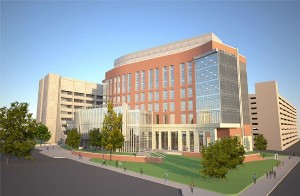Apr 29 2014
Vanderbilt University’s Board of Trust has approved the construction of a seven-story tower on campus as part of an effort to further strengthen the institution’s growing reputation as a major producer of intellectual leaders, entrepreneurs and innovators.
 A rendering of the new Engineering and Science Building. (Wilson Architects Inc./Vanderbilt University)
A rendering of the new Engineering and Science Building. (Wilson Architects Inc./Vanderbilt University)
The 230,000-square-foot Engineering and Science Building is designed to foster project teamwork and offer programs, instrumentation areas and core research space that will promote interdisciplinary work, particularly in engineering and related fields. It will connect to one of the School of Engineering’s landmark buildings, Olin Hall, through a double-height atrium that will lead to the new highly interactive learning and research environment. The nearly 40-year-old Olin Hall currently houses the mechanical engineering and chemical and biomolecular engineering departments.
Construction is scheduled to begin in May 2014 following the university’s Commencement exercises.
“We want to continue to attract and recruit the best students and provide them with exceptional research experiences at the undergraduate and graduate levels. This new facility will allow for even greater collaboration between students and faculty across disciplines so we can deliver scholarship of the highest caliber to address important societal issues,” Philippe Fauchet, dean of the Vanderbilt School of Engineering, said.
A key feature of the new building is an Innovation Center designed to connect students and faculty with technology transfer and industry mentors to accelerate the transfer of laboratory discoveries and student-developed concepts to the marketplace. Students participating in the center will experience the value of interdisciplinary teamwork and carry this model forward as they become leaders.
An Undergraduate Commons in the building will feature student-centered space designed to spark intellectual discussions and studies. Located next to the research laboratories and above the Innovation Center, the commons will help connect students with other researchers and innovators working in the building.
A cleanroom and advanced imaging facilities will provide capabilities that students and faculty need to advance discoveries in areas such as nanocomposites, smart materials, advanced energy storage and nano‐bio‐technology.
Five floors of the building can support a variety of research laboratories and new trans‐institutional programs designed to attract and retain top academic leadership in the School of Engineering, the College of Arts and Science and the School of Medicine.
The building is expected to be completed in the summer of 2016 at an estimated cost of $109 million.